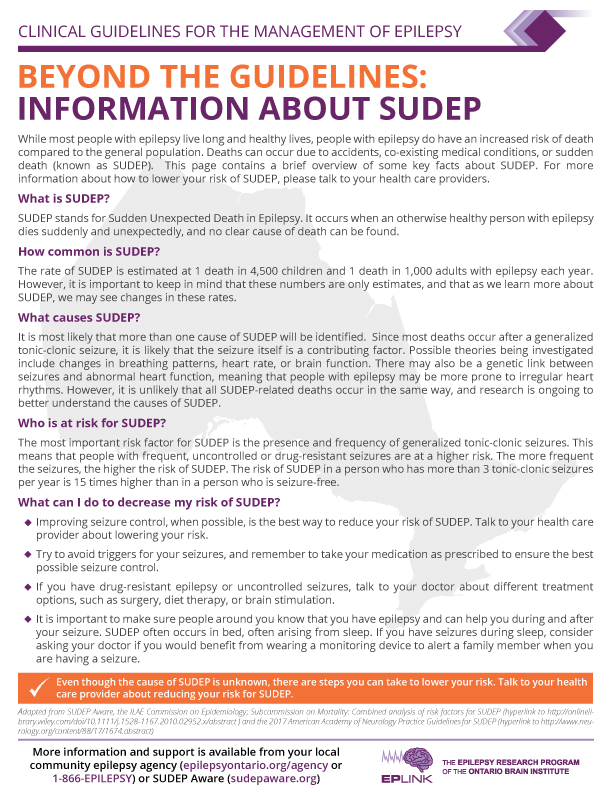Click here to download a PDF of the info sheet.

While most people with epilepsy live long and healthy lives, people with epilepsy do have an increased risk of death compared to the general population. Deaths can occur due to accidents, co-existing medical conditions, or sudden death (known as SUDEP). This page contains a brief overview of some key facts about SUDEP. For more information about how to lower your risk of SUDEP, please talk to your health care providers.
SUDEP stands for Sudden Unexpected Death in Epilepsy. It occurs when an otherwise healthy person with epilepsy dies suddenly and unexpectedly, and no clear cause of death can be found.
The rate of SUDEP is estimated at 1 death in 4,500 children and 1 death in 1,000 adults with epilepsy each year. However, it is important to keep in mind that these numbers are only estimates, and that as we learn more about SUDEP, we may see changes in these rates.
It is most likely that more than one cause of SUDEP will be identified. Since most deaths occur after a generalized tonic-clonic seizure, it is likely that the seizure itself is a contributing factor. Possible theories being investigated include changes in breathing patterns, heart rate, or brain function. There may also be a genetic link between seizures and abnormal heart function, meaning that people with epilepsy may be more prone to irregular heart rhythms. However, it is unlikely that all SUDEP-related deaths occur in the same way, and research is ongoing to better understand the causes of SUDEP.
The most important risk factor for SUDEP is the presence and frequency of generalized tonic-clonic seizures. This means that people with frequent, uncontrolled or drug-resistant seizures are at a higher risk. The more frequent the seizures, the higher the risk of SUDEP. The risk of SUDEP in a person who has more than 3 tonic-clonic seizures per year is 15 times higher than in a person who is seizure-free.
- Improving seizure control, when possible, is the best way to reduce your risk of SUDEP. Talk to your health care provider about lowering your risk.
- Try to avoid triggers for your seizures, and remember to take your medication as prescribed to ensure the best possible seizure control.
- If you have drug-resistant epilepsy or uncontrolled seizures, talk to your doctor about different treatment options, such as surgery, diet therapy, or brain stimulation.
- It is important to make sure people around you know that you have epilepsy and can help you during and after your seizure. SUDEP often occurs in bed, often arising from sleep. If you have seizures during sleep, consider asking your doctor if you would benefit from wearing a monitoring device to alert a family member when you are having a seizure.
